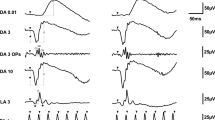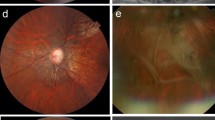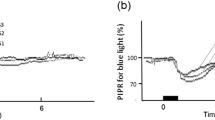Summary and conclusions
-
1.
ERGs were recorded pre- and post-operatively from 37 eyes of 22 patients with senile cataracts, free from complications. The age of the patients ranged from 59 to 88 years.
-
2.
The ERGs were obtained from dark adapted eyes with white light at 10 intensity levels and with red and blue light.
-
3.
The results of this study can be summarized by saying that cataractous lens changes affect the ERG by modifying the retinal illumination, enhancing or reducing it. These effects can only be fully appreciated when stimuli of different intensity levels are used.
-
4.
In 23 eyes the b-wave amplitude was generally lower in the aphakic state; in 5 it was higher. In another 5 there was no difference pre- and post-operatively; in 4 the results were equivocal. With high intensity stimuli there was in many eyes no marked difference in response between the phakic and aphakic state. With the lower intensities the differences were in general more pronounced; also, the rods tended to be saturated or nearly saturated with lower flash intensities. This occurred especially in patients whose cataract consisted mainly of a posterior cortical plaque. The patients in whom the b-wave was higher post-operatively had dense, mature cataracts.
The lower post-operative b-wave amplitude in two-thirds of the patients is explained by the action of the cataractous lens changes as a diffusing screen. Consequently, the effect of the low intensity stimuli is particularly enhanced. With flashes of high intensity the rods are saturated in both the phakic and aphakic state.
-
5.
The amplitude of the a-wave differed but little pre- and post-operatively. Where it was lower, the differences tended to occur at the high flash intensities.
-
6.
In a large number of cases colored stimuli elicited a higher response when the eye had been made aphakic.
-
7.
The duration of the b-wave tended to be larger pre-operatively than postoperatively. The difference was more pronounced with the lower flash intensities.
-
2.
The goal of this study was to investigate the effect of cataractous lens changes on the ERG rather than the value of ERG in the functional testing of cataractous eyes. All 22 pateints selected had presumably a good prognosis and the post-operative results were satisfactory. The results of this study have, therefore, no direct bearing on the question to what extent ERG is a helpful tool in the pre-operative evaluation of eyes with senile cataracts.
Résumé
L'électrorétinogramme de 37 yeux de 22 malades, âgés de 59 à 88 ans, atteints de cataracte sénile simple, a été enregistré avant et après l'opération. Examen après adaptation à l'obscurité; stimulation avec lumière blanche de 10 niveaux d'intensité, ainsi qu'avec lumière rouge et bleue.
Les résultats montrent que dans les yeux avec cataracte l'effet de la lumière est augmenté, surtout avec des stimuli d'intensité basse, dû à la diffusion de la lumière par le cristallin cataracteux, si l'opacité n'est pas trop dense. Autrement, l'effet de la lumière est diminué.
Zusammenfassung
Es wurden von 37 dunkeladaptierten Augen von 22 Patienten (Alter 59 bis 88 Jahre) vor und nach der Operation für unkomplizierte Cataracta senilis Elektroretinogramme abgeleitet. Zehn Intensitätsstufen von Weißlicht wurden verwendet sowie rotes und blaues Licht.
Der Vergleich der Resultate im phakischen und aphakischen Auge zeigt, daß die kataraktöse Linse die Netzhautbeleuchtung erhöht, indem sie als Zerstreuungsschirm wirkt. Dieser Effekt ist am auffälligsten, wenn niedrige Lichtstärken zur Stimulierung verwendet werden. Mit den höchsten Intensitäten ist kaum ein Unterschied vorhanden, da dann der Stimulus für das phakische und aphakische Auge gleich supramaximal ist. Wenn die Katarakt aber sehr dicht ist, vermindert sie durch Lichtabsorption die Netzhautbeleuchtung. Selbst hohe Lichtintensitäten sind dann submaximal für das kataraktöse Auge.
Similar content being viewed by others
References
Karpe, G. & B.Vainio-mattila. The Clinical Electroretinogram. III. The Electroretinogram in Cataract. Acta ophthal. Kbh. 29, 113–128 (1951).
Burian, H. M. & J. T.Pearlman. Evaluation of the Amplitude of the b-wave of the Human Electroretinogram. Amer. J. Ophthal. 58, 210–216 (1964).
Author information
Authors and Affiliations
Additional information
From the ERG Laboratory of the Department of Ophthalmology and the Neurosensory Center (Paper No. 80) of the College of Medicine of the University of Iowa. The work of the ERG Laboratory is supported by Grant No. B-349; the Neurosensory Center, by Program Project Grant B-3354 of the National Institute of Neurologic Diseases and Blindness, National Institutes of Health, Bethesda, Maryland.
Rights and permissions
About this article
Cite this article
Burian, H.M., Burns, C.A. A note on senile cataracts and the electroretinogram. Doc Ophthalmol 20, 141–149 (1966). https://doi.org/10.1007/BF00165412
Issue Date:
DOI: https://doi.org/10.1007/BF00165412




